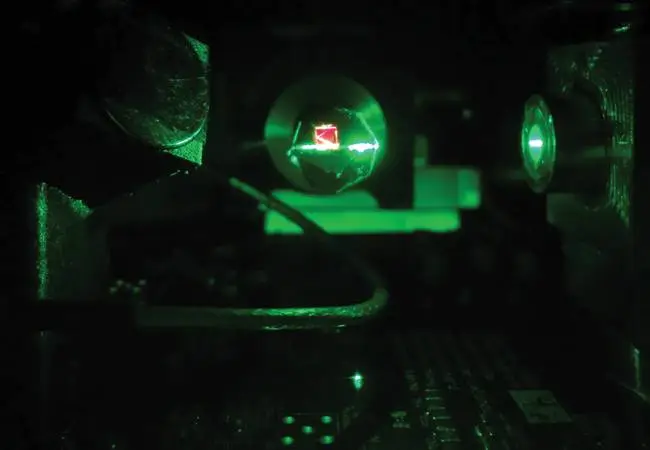Quantum Magnetometers are Crossing the Magnetic Frontier
A green laser shines on a nitrogen-vacancy (NV)-center diamond. This excitation polarizes the spin system and results in the red light emission. The spin state determines the intensity of this photoluminescence.

The number and variety of device prototypes that have advanced from the lab into the real world in recent years offers irrefutable evidence that quantum sensing technologies are making major forward strides. As end users and systems integrators increasingly deploy these prototypes to perform useful, industrial applications, some have begun to emerge as bona fide disruptors to existing commercial systems.
The innovative prototypes that have achieved this status have met two critical benchmarks. First, they effectively harness the advantages of quantum technology to improve upon the capabilities of baseline, nonquantum systems. Second, they target essential applications, often as these applications evolve or pose new challenges that push the limits of the current solutions.
Quantum magnetometers, particularly those based on nitrogen-vacancy (NV) centers in diamonds, are among these innovations, offering a powerful alternative to conventional magnetic-based systems. For decades, magnetometers have been used in applications ranging from anti-submarine warfare to compassing technology. More recently, magnetic-based navigation has gained favor in global navigation satellite system-denied environments. In the present age of minerals, geophysical surveying is moving quickly toward autonomous platforms that use cost-effective and compact magnetometers to perform high-resolution surveys. And, with conflict zone complexities intensifying, so-called advanced concealment techniques — sensing technologies that “see” through smoke, underground, and underwater — are paramount.
Because NV centers are atomic, their applicability is also extending into nano- and micrometer applications in the medical space. Critically, quantum magnetometry is also a room-temperature technique, which further broadens its application potential.
Both as an improvement to conventional vector magnetometry, as well as in its widened range of supported use cases, NV centers are redefining how magnetometry can be used in the field by offering superior performance and situational awareness.
The quantum edge
At their core, quantum magnetometers harness the quantum mechanical properties of specific materials to detect magnetic fields with exceptional precision and sensitivity. These types of magnetometers — atomic vapor magnetometers, for example — have driven the adoption of large-scale regional magnetic surveys for geophysical modeling.
Parameters such as size, drift, and environmental interference often constrain classical sensors. Quantum sensors by contrast can measure fields with precision down to one millionth of Earth’s magnetic signal, enabling the detection of magnetic signals over longer ranges and in environments where signals are weak or noisy. Additionally, the stability of quantum reference states enables drift-free measurements, circumventing the need for constant recalibration and ensuring that users can compare data sets with high reliability. And quantum sensors optimize size, weight, and power parameters. Miniaturized designs make them ideal for deployment on small autonomous platforms such as drones, or in restricted spaces such as inside medical equipment or in underground sensors.
A flawed photonic system
NV centers are point defects in a diamond lattice in which a nitrogen atom replaces a carbon atom adjacent to a vacancy, which is an empty lattice site. This structure results in a two-electron spin system with unique quantum properties that can be optically initialized and read out.
NV centers are particularly suited for magnetometry because of their quantum mechanical spin-1 property, which includes three energy levels: ms = 0, ±1. These energy levels are sensitive to the local magnetic field via the Zeeman effect, especially along the NV axis. Visible (green) laser excitation polarizes the spin system and results in red light emission, or photoluminescence, the intensity of which depends on the spin state. Upon the application of microwaves at resonant frequencies corresponding to the spin transitions, the fluorescence intensity dips. This action provides a means to detect magnetic fields via optically detected magnetic resonance.
Due to the tetrahedral symmetry of the lattice, a diamond crystal typically contains NV centers in four orientations. With appropriate signal processing and a carefully applied bias magnetic field, each orientation can be resolved, enabling full vector magnetometry. This potential to reconstruct the vector components of magnetic fields in three dimensions is imperative for applications ranging from navigation to the advanced calibration of systems in complex environments.
Field-ready advantages
Traditional high-sensitivity vector magnetometers include superconducting quantum interference devices and vectorized atomic vapor magnetometers. These systems often require the use of cryogenics, or large, power-hungry electronics. NV magnetometers operate at room temperature with compact form factors and deliver similar or even superior performance in the field. Notably, since these magnetometers are based on a solid-state material — diamond — they avoid the need to vaporize a vacuum cell; this process requires heating elements that are apt to consume large quantities of energy.
The performance benefits of NV magnetometers are particularly evident in challenging or dynamic environments. Because of their tolerance to high magnetic field gradients, due to the small sensing volume, NV centers maintain high resolution even in areas with steep field variations. The robustness of these quantum sensors to mechanical and thermal disturbances is another area in which the benefits are clear, especially for field deployment. The diamond host is both a mechanical and thermal insulator. Its inertness and stability enable sensing in conditions that would degrade or destroy conventional sensors.

